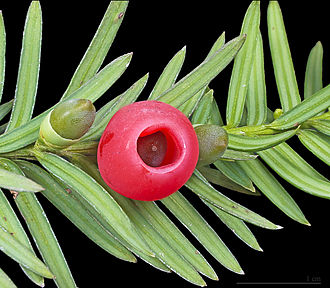Taxus

Taxus is a genus of coniferous trees or shrubs known as yews in the family Taxaceae. They are relatively slow-growing and can be very long-lived, and reach heights of 2.5–20 metres (8.2–65.6 ft), with trunk girth averaging 5 metres (16 ft).[1] They have reddish bark, lanceolate, flat, dark-green leaves 10–40 millimetres (1⁄2–1+1⁄2 in) long and 2–3 mm (3⁄32–1⁄8 inch) broad, arranged spirally on the stem, but with the leaf bases twisted to align the leaves in two flat rows either side of the stem.[2] The oldest known fossil species are from the Early Cretaceous.[3]
The seed cones are highly modified, each cone containing a single seed 4–7 mm (5⁄32–9⁄32 inch) long partly surrounded by a modified scale which develops into a soft, bright red berry-like structure called an aril, 8–15 mm (5⁄16–19⁄32 inch) long and wide and open at the end. The arils are mature 6–9 months after pollination, and with the seed contained are eaten by thrushes, waxwings and other birds, which disperse the hard seeds undamaged in their droppings; maturation of the arils is spread over 2–3 months, increasing the chances of successful seed dispersal. The male cones are globose, 3–6 mm (1⁄8–1⁄4 inch) across, and shed their pollen in early spring. Yews are mostly dioecious, but occasional individuals can be variably monoecious, or change sex with time.[2]
All of the yews are very closely related to each other, and some botanists treat them all as subspecies or varieties of just one widespread species; under this treatment, the species name used is Taxus baccata, the first yew described scientifically.[4] Other sources, however, recognize 9 species, for example the Plant List.
Foliage of Mexican yew
The most distinct is the Sumatran yew (T. sumatrana, native to Sumatra and Celebes north to southernmost China), distinguished by its sparse, sickle-shaped yellow-green leaves. The Mexican yew (T. globosa, native to eastern Mexico south to Honduras) is also relatively distinct with foliage intermediate between Sumatran yew and the other species. The Florida yew, Mexican yew and Pacific yew are all rare species listed as threatened or endangered.
All species of yew contain highly poisonous taxine alkaloids, with some variation in the exact formula of the alkaloid between the species. All parts of the tree except the arils contain the alkaloid. The arils are edible and sweet, but the seed is dangerously poisonous; unlike birds, the human stomach can break down the seed coat and release the taxanes into the body. This can have fatal results if yew ‘berries’ are eaten without removing the seeds first. Grazing animals, particularly cattle and horses, are also sometimes found dead near yew trees after eating the leaves, though deer are able to break down the poisons and will eat yew foliage freely. In the wild, deer browsing of yews is often so extensive that wild yew trees are commonly restricted to cliffs and other steep slopes inaccessible to deer. The foliage is also eaten by the larvae of some Lepidopteran insects including the moth willow beauty.
